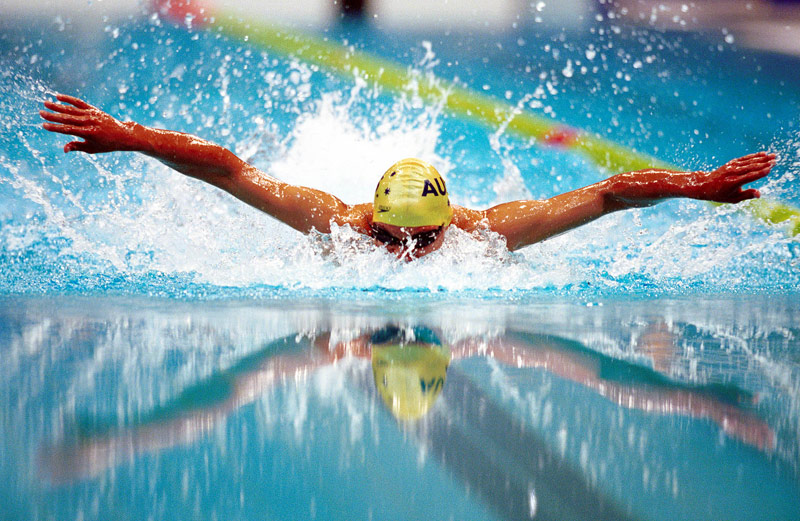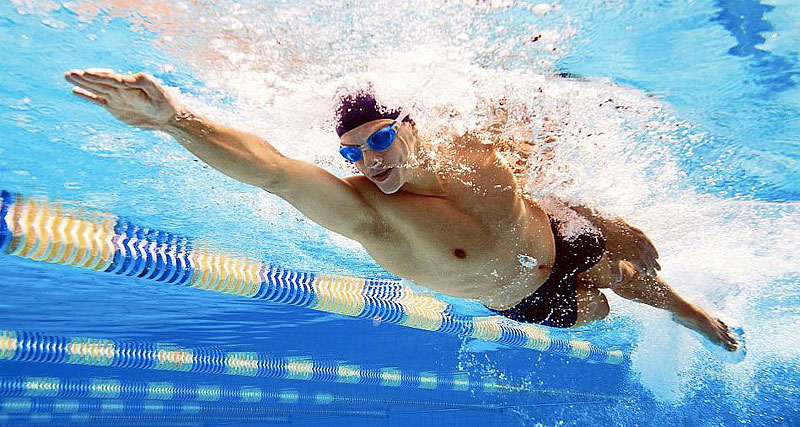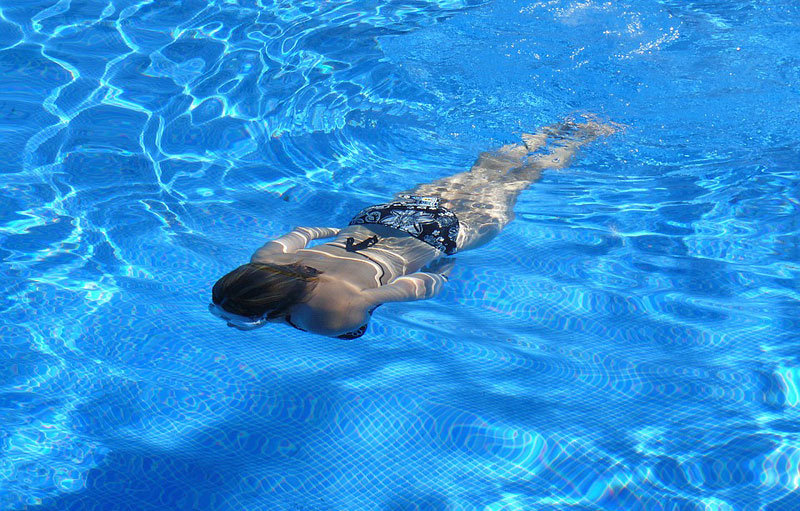
Heading to the pool might not be the first thing that comes to mind when it’s time to shape up — but it should be. Not only could you burn upwards of 400 calories in an hour, but you’ll also stoke your metabolism and firm up your entire body without putting tons of stress on your joints (or melting into a puddle of sweat). To reap the head-to-toe benefits, though, you’ll need to know proper form and technique. Whether you’re a total beginner or are looking to brush up on your skills, there are a few common swimming mistakes we’re all guilty of. Put these pros’ tips into practice and soon you’ll be swimming laps with the best of ‘em.
8 Beginner Swimming Mistakes (and How to Swim Like a Pro!)
Mistake #1: You hold your breath.
“When we’re little or first learning how to swim, a lot of us are taught to take a deep breath, hold it, and put our faces in the water,” says Scott Bay, coaches committee chair for U.S. Masters Swimming and an ASCA Level 5 certified Masters swim coach. “But you’re burning oxygen for fuel when you do that.” Think about it — if you’re out running a 5K, are you going to hold your breath and run? No, because it deprives your muscles of much-needed oxygen.
How to fix it: First, practice on dry land. Take a deep breath in through your mouth and start to slowly exhale through your nose. As you do, hum, suggests Bay. “If you hum while you breathe out of your nose, it’ll help you maintain a proper pace — you’re forced to do it slowly rather than rush through it,” he says. The next step: breathing in the water. After you take your breath and have your face in the water, work on slowly exhaling — again, through your nose — and then lift your face out of the water when it’s naturally time to do so.
Mistake #2: You take your head out of the water to breathe.
We know, it sounds counterintuitive. How are you supposed to actually breathe if you don’t lift your head out of the water? Let us clarify: It’s more about keeping your head in the water, while lifting your face out. If you pop your head up each time you need to take a breath, you throw your body’s alignment out of whack. Often that’ll mean forcing your hips lower into the water, which is the opposite of what you want, making your straight swim more of a zig-zag, says Linsey Corbin, CLIF triathlete and five-time Ironman champion.
How to fix it: Focus on keeping your head down, with the chin tucked into your neck, says Corbin. When it’s time to breathe, take a breath of air to the same side as the arm that is out of the water, keeping your head in the water (visualize rotating your head just enough so that your mouth is clear for air, but that’s it).

Mistake #3: You let your hips sink.
Doing this creates more drag in the water. And more drag equals more resistance, which ultimately slows you down. Corbin says the goal is to “stay flat and float on top of the water,” rather than dropping in it. Too often beginners default to movements that force their hips down, like letting their feet sink when they should be just below the water’s surface, thus forcing their body to work even harder to get from point A to point B.
How to fix it: Invest in a swim snorkel (or grab the one you packed for your last Caribbean adventure), suggests Corbin. “Putting on a snorkel allows you to not have to focus on breathing to the sides,” she says. “Instead you can focus on your arms pulling through the water, your breath being released at a steady pace, and keeping your hips as high up as you can.” Use it in practice a few times a week to hone in on your form before worrying about more advanced work, like increasing pace and speed drills.
Mistake #4: You keep your hips straight.
Another common hip problem: Not rotating them. Many swimmers rely on their upper body, or just their legs, to propel them through the water. But the majority of your power comes from the hips because they control both the upper and lower body, so depriving yourself of that movement will slow down your momentum, says Corbin.
How to fix it: “Start off with visualization. Imagine opening your belly button to the walls of the pool with each stroke, and think about rotating with your core muscles,” suggests Corbin. “Utilizing your core is going to rotate your trunk and help push you through the water faster.”
To practice getting into the habit, Corbin suggests kicking on your side, belly button toward the wall, with your bottom arm extended overhead, so your head rests on that arm. Do that for one lap, then switch sides. The movement will help you become familiar with how your hips feel when they’re in full rotation, which will in turn help you identify when to start rotating back the other way. For more of a challenge, hold the side position for a few seconds between every stroke, alternating back and forth all the way down the length of the pool.

Mistake #5: You point your toes.
Bay says this is a common mistake, as it’s easy to forget about the little guys at the end of your foot. But they play a big role in determining your speed and direction, he says, and pointing them straight out, so that they’re fully flexed, “is like kicking and not going anywhere because it tightens up your ankles.” Swimmers actually want loose, flexible ankles in the water to help quicken their pace.
How to fix it: Practice curling your toes, as if you were trying to pick up a penny off of the floor, says Bay. “It keeps the ankles loose while putting your foot in the right direction.” It’s even a good practice outside of the pool — when you have some time to relax in the living room, put a pile of pennies on the floor next to a small bowl and practice transferring the pennies to the bowl with your toes to get more familiar with how your toes feel when curled.
Mistake #6: You rely too much on your upper body.
“Keep in mind that swimming utilizes your whole body,” says Corbin. “Most people make the mistake of believing it’s just a workout for your upper body.” But when you depend on your shoulders, arms and lats to do all the work, not only will you exhaust those muscles faster than you want, you’ll risk not completing a full stroke properly — meaning you won’t slice through the water as quickly.
How to fix it: “Try to keep an even balance across your upper body, core and lower body throughout your workout, rather than over-compensating in one of those areas,” says Corbin. “Use your arms for pulling your body through the water, your core to rotate in the water, and your legs for the kick, which provides forward momentum.” If you find yourself weak in one area — say, the lower body — practice doing kick drills using a kick board a few times per week, she suggests. And don’t be afraid to hit the deck for some strength work, too. Hello, squats.
Mistake #7: You don’t finish your stroke.
“Unfortunately, a lot of people pull their hand out of the water before it reaches their hip because they’re trying to get to the start of a new stroke too quickly,” says Bay. “That’s counterintuitive though. You’re shortchanging yourself [by] not getting the most energy out of the work that you just put in.”
How to fix it: Simply put, finish the work you started. When you’re swimming, think of your forearm as a giant paddle that is going to push water backward while you move forward, says Corbin. As your hand enters the water (making sure that your arms don’t cross over to the opposite side of your body), keep your elbow high and drive the forearm through the water while rotating the elbows. Continue to push that water backward until you reach your hips, and then begin the “recovery” part of the stroke — lifting your arm out of the water and back to the beginning of a new stroke.

Mistake #8: You practice swimming for a long time at a slower pace.
There’s definitely a place for slow and steady as a beginner swimmer, but the problem occurs when you stay in the comfort zone of leisurely logging laps, says Corbin. Eventually, you can get lazy about form, since you’re just focusing on getting from point A to a really far point B.
How to fix it: Start incorporating speed drills. “Swimming short and fast enforces better form than swimming long and slow,” says Corbin. Two to three times a week, try swimming for time, rather than distance. Sites like USA Swimming and apps like Speedo Fit provide fun, fast workouts that help you focus on form. Not quite ready to jump into the fast lane? Some one-on-one or group sessions can go a long way, too.




Leave a Reply